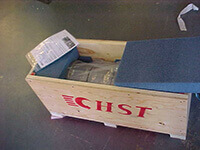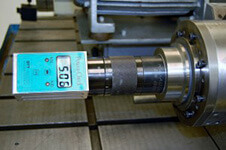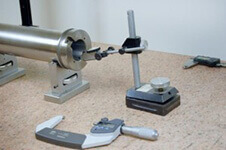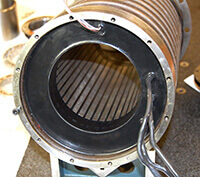Spindle Repair Services and Spindle Rebuilding
100,000+ successful repairs
HST has more than 30 years of experience repairing spindles. We’ve probably repaired a spindle similar to yours. Our technicians understand the theory behind spindle design. They are fully trained in the application of super precision spindle bearings. So when you send your spindle to HST you get our decades of experience along with expert training for an OEM-quality rebuild. And we back that up with a full written warranty.
We will do everything that is required to restore your spindle to OEM like-new condition. HST has several goals for each spindle repair we do:
- Determine the cause of failure (FEQA)
- Repair the spindle to “As-New” condition
- Protect the spindle for safe transit
- Provide useful information to help our customers avoid future failures
Depending on the type of spindle the repairs may include:
- Log in and check data base for any previous repairs
- Dismantle, clean and inspect the spindle
- Evaluate all components, prepare and submit quote and report.
- Replace all bearings with top name brand Super Precision Spindle Bearings ABEC 7 or ABEC 9
- Set bearing preload as required this may include:
- Making new spacers
- Grinding existing spacers
- Grinding covers or other components as required to set the preload
- Clean and lubricate (Link to FAQ 9)all bearings (except sealed)
- Replace all seals and o-rings
- Replace drawbar springs
- Replace Gripper assembly (as needed)
- Set drawbar pull force
- Restore any damaged shaft bearing journals (GPG)
- Restore any damaged housing bearing journals (GPG)
- Restore tool interface surfaces such as tapers (GPG)
- Balance rotating components
- Assembly
- Lubrication “break-in”
- High Speed Trim Balance
- Set position sensors
- Set rotary encoders
- Test and adjust PLG cards.
- Pressure test coolant jackets
- Priming and Painting
- Pre-ship check list
- Blow out any residual coolant
- Torque seal bolts
- Photograph
- Final Wipe-Down
- Apply rust inhibitor
- Wrap in corrosion preventative paper
- Check that all components are together such as customer tooling
- Crating
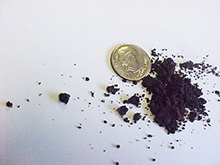
Contamination From Spindle Lubrication Port
Log-In
The first step is to log-in and check the spindle serial numbers against our data base of over 100,000 spindle repairs. Once logged in and photographed the spindle next goes to our breakdown and clean area. Here the spindle is completely disassembled and thoroughly cleaned.
Breakdown and Clean
Depending on the type and condition of the spindle, proper breakdown and cleaning can be labor intensive and time consuming. Taking apart a spindle may include cutting off seized nuts and pressing off rotors in our 100 ton press. Old paint is stripped off. All orifice and lubrication plugs are removed to get at minute internal passages that often harbor contamination. Scale and corrosion are removed from water jackets and cooling surfaces. Tapped holes are degreased, blown out and threads checked. Every spindle component is thoroughly degreased prior to inspection. Bearings and other components are examined to determine the cause of the failure.

Our customers only see the black housing of an Okuma spindle. But the inside is sparkling clean.
This contamination was removed from a lubrication port. The spindle was recently repaired by a HST competitor. But with a clogged lubrication port the bearings didn’t last long. Not everybody is as thorough as HST.
Our customers will probably never see the inside of their spindle cooling jacket like this Okuma unit (below). However, at HST they are cleaned until they shine. The surfaces inside the jacket are critical for proper heat dissipation. Any scale or corrosion not removed negatively impacts the thermal transfer coefficient causing spindles to run hotter. Running hotter increases the likelihood of premature failure.
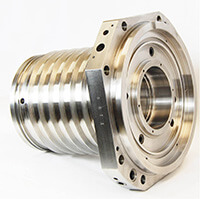
The Spiral Cooling Fins inside an Okuma housing
On To Metrology
After all components are thoroughly cleaned they make their first trip to our metrology room. Because extreme accuracy is required, dimensional examination is conducted in an environmentally controlled clean area. All instruments used for measuring are calibrated to a certified set of gages just prior to each examination. After calibration all critical surfaces are measured to micron tolerances. A high performance spindle may have 14 or more surfaces that need to be examined including bearing journals, spacers, shoulders and tapers.
Once instrument calibration is verified, the following dimensions are examined and recorded*:
|
|
|
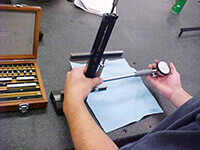
Calibrating a bore gage prior to inspecting a housing
Some of the shaft surfaces checked for TIR, concentricity, perpendicularity and flatness. Measurements are in microns
*Exact areas inspected depend on type of spindle. If the spindle is motorized all electrical components are checked for shorts, continuity and general condition.
Evaluation Report and Quote
When our inspection is complete we generate a comprehensive evaluation report for our customer along with photographs of the damage that caused the failure. At this time we know exactly what will be required to restore the spindle to like new condition and a firm quote is prepared.
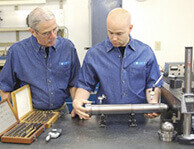
Checking concentricity of a spindle shaft
The evaluation report will specify exactly what we found and offer a likely cause of failure. With the report and a firm quote the customer can make an informed decision as to how to proceed. The customer is under no obligation for any work completed prior to approval. Click Spindle repair costs for more information.
SO FAR NO CHARGE!
By completing a full evaluation first we can offer our customers an honest and best price for the repair. We do not have to “pad” the price to cover unknown contingencies. On the flip side we limit our exposure to unforeseen problems.
We are completely confident that our prices are very competitive with any quality repair house. If the customer declines the repair we will return the spindle at no charge or even ship it to one of our competitors.
Putting It All Back Together *
Once the repair is approved HST performs the following:
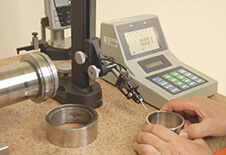
Checking flatness and parallelism on a spacer
- Replace all bearings. Our technicians are as demanding as the high end OEMs. Like the OEMs, HST only purchases Super Precision ABEC 7 or ABEC 9 spindle bearings from authorized distributor. See why that’s important to you (click here).
- We buy matched sets or matched quads, and we NEVER reuse bearings. Our technicians are very fussy about their bearings and they test each set prior to installation. For more information click Super Precision .
- Grind and lap all spacers to specified tolerances. (usually +/- 1 µm) Our cup wheel grinder is remarkably precise. But we still hand lap the spacers that last 50 millionths of an inch. Exact spacer sizing is critical for proper bearing operation. If they are not precisely correct one bearing will carry excessive load and the other bearing will unload. They will fail prematurely.
-

Some of the shaft surfaces checked for TIR, concentricity, perpendicularity. Measurements are in microns.
Kiss Grind (Breeze Grind) any critical surfaces that have minor irregularities or that do not need to be returned to original surface such as certain ID tapers. These surfaces must perfectly match certified standards.Click Kiss Grind for more information.
- Dimensional Restoration. Journals, tapers or other critical surfaces that are outside specification limits are restored to proper dimension with our GPG process. Because we do our own in-house grinding we can minimize the turnaround time and cost for this type of surface restoration. Our Kellenberger is one of the best universal grinders available. It matches our talent. Our hard chrome plating is guaranteed for life.
- Repair any damaged surfaces such as wrench flats or threads. Where practical original parts are micro-welded and re-finished. Where required we can fabricate new. Special care must be taken to avoid warping. All surfaces must be dimensionally true to within extremely tight tolerances.
- Repair / replace all damaged components such as labyrinth seals. HST will weld up old balancing holes and refinish surfaces.
- Assemble Stator and other “Static” Components. Motor windings, coolant jackets are installed will all new seals. All associated components are re-tested and the coolant jacket is pressurized and checked for leaks.
- Assemble Rotor Components. Depending on the type of spindle various rotating components may need reassembly such as motor rotor or inertial weights.
- Balance all rotating components. Prior to final assembly individual rotating sub-assemblies are dynamically balanced. This reduces final assembly trim balancing.Click Balancing for more information.
-
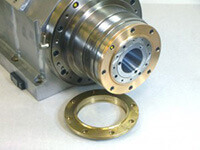
HST manufactured a new air knife for this CMS Brembana spindle
Lubricate bearings. If the spindle uses grease bearings, they are precision lubricated in a separate self-contained clean area.HST uses appropriate grade Kluber greases specifically formulated for high speed spindle operation. Click Lubrication for more information.
- Assemble and Preload Bearings. The utmost care must be used when handling and assembling precision bearings. Additionally, preloaded components must be perfectly matched.With rigid preload spacers, settings are measured in the millionths of an inch. Click Preload for more information.
- Preliminary Run-In. HST normally does bearing break in prior to installing the draw bar and gripper assembly.Grease bearings may take up to 12 hours to properly run-in.The spindle will be trim balanced during this procedure.
- Drawbar / Gripper Assembly. For spindles with drawbars, HST replaces and re-lubricates all of the draw bar springs.
All seals are replaced in the drawbar actuator and rotating union. The components are set to OEM specifications.Drawbartension is set and checked with one of our digital dynanometers.
- Full Run-In. After passing the initial vibration analysis, the spindle is next run up through an appropriate breaking procedure. Motorized spindles are run off one of our Spindel high frequency inverters.Non-motorized spindles are run on one of our motorized test benches.
- Vibration analysis / trim balance. After final run-in each spindle is run through a thorough vibration analysis at all anticipated running speeds. The spindles are instrumented for vibration, temperature and balance.These sensors reveal the quality of the repair.The front and rear journal areas are checked separately. We adhere to stringent acceleration and velocity pass/fail criteria.
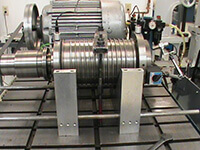
An instrumented Mori Seiki MH-63 ready for run-in.
If required final trim balancing is performed. Click Trim Balancing for more information
-
- Sensors and Transducers.All spindle sensors and transducers are set to original specifications and tested.
- Paint and Finish. Where appropriate the spindle next goes to our spray booth. It is painted and prepped for final inspection. HST applies high quality enamel paint or when requested a two part epoxy paint can be applied.
- Final QA The spindle goes through the final Quality Assurance inspection. Torque Striping is applied, shipping photos are snapped and the service report is completed and logged.
-
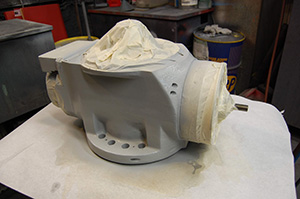
Mazak Integrex with a fresh coat of 2 part epoxy paint.
Crate and Ship. HST care and quality continues until the spindle is shipped.Proper protection is essential to assure that the spindle arrives in pristine condition. Moisture is an enemy so every spindle is wrapped inCortec Vapor Phase Corrosion Inhibitor (Mil-Spec B220119/020). Impact to the spindle during shipment can cause Brinelling and even vibration can cause false Brinelling. The spindle is carefully padded and isolated from exterior packaging. The exterior packaging is always rugged.Once your spindle is properly protected, HST will arrange expedited delivery. We have arrangements in certain areas for same day delivery. Why use somebody’s “B” team when our “A” team is just hours away.
*The above description is a typical overview to provide our customers an idea of some of the work that goes into a typical spindle repair.
The actual work and sequence can vary depending on the type and requirements of a particular spindle.
